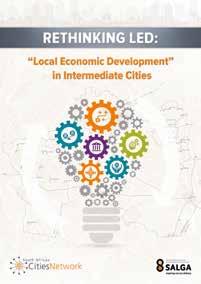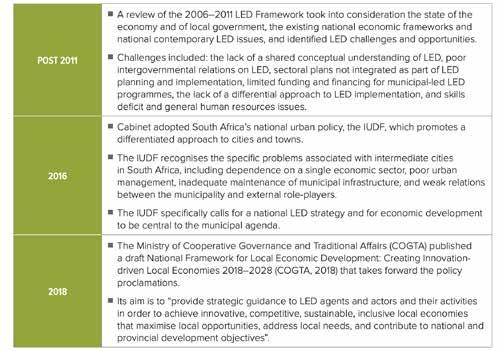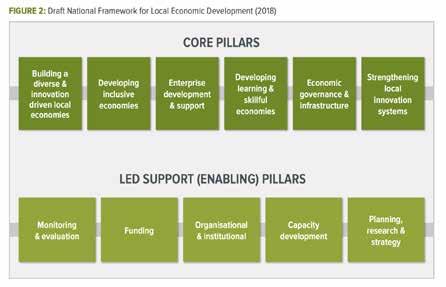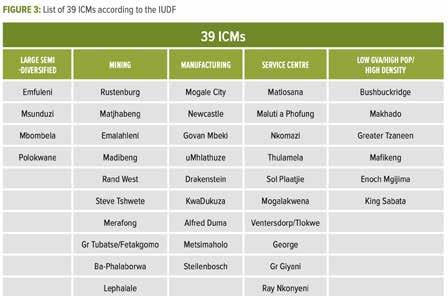
21 minute read
Rethinking LED LED in intermediate cities
LED in intermediate cities
Rethinking LED: “Local Economic Development” in Intermediate Cities is the latest volume in a series of exploratory studies on the “differentiated approach to governance” focusing on intermediate cities, by the South African Cities Network (SACN). The first four volumes were a data-driven study seeking to define “secondary cities” (2012); a qualitative study into six intermediate cities exploring possible differences or uniqueness compared to metros (2014); a deeper study into apartheid’s displaced settlements examining the need for a more nuanced articulation of differentiation, drilling down to a sub-municipal level (2016); and a study assessing the interpretation of “spatial transformation” contained in the national urban policy in intermediate cities compared to metros (2017). The series has become an important and consistent reference point for building national attention and understanding around intermediate cities
Advertisement
We extend our thanks to the South African Cities Network for the following extracts. SACN 2019. Rethinking LED: “Local Economic Development” in Intermediate Cities. Johannesburg: South African Cities Network. Available online at sacities.net. ISBN: 978-0-6399215-6-3 © 2019 by South African Cities Network. Rethinking LED: “Local Economic Development” in Intermediate Cities is made available under a Creative Commons Attribution-NonCommercial-ShareAlike 4.0 International Licence. To view a copy of this licence, visit creativecommons.org/licenses/by-nc-sa/4.0/.
Intermediate cities have an important role to play in regional and rural development, and contribute to the national economy. However, their economic growth is generally slower than in metropolitan areas, because their economies are significantly more vulnerable. And, unlike metropolitan cities, few (if any) of South Africa’s intermediate cities have managed to change their economic trajectory.
This research explored local economic development (LED) within intermediate cities, using a combination of desktop research, participatory action research (to garner the views and experience of municipal practitioners), and case studies of Mangaung, Rustenburg and Sol Plaatje. These three cities represent common LED characteristics of intermediate cities: ● Their economies tend to be “old” and depend on a single sector, and
are thus vulnerable to
national decisions.
● They play an important regional role within their rural hinterlands, and have links to larger urban areas. ● Their infrastructure is ageing, and their municipal financial standing is weak.


The study found that LED is an ambiguous concept that includes both pro-poor and pro-development economic development approaches.
Within municipalities, there is confusion about the LED department’s role, and LED is not considered a high priority. As a result, LED departments lack capacity and resources, and produce strategic plans that are rarely updated. The plans tend to be disconnected from reality, lack strong economic rationale or make simplistic assumptions about the economic value chains, and assume that funding will come from other spheres of government. The private sector is also not aligned with the municipality, and economic analysis and intelligence are lacking.
Furthermore, the municipalities depend heavily on national grants but have little or no say in the plans developed and policy decisions taken by national (and provincial) government, although these plans and decisions affect their local economies. The dependency on national grants means that municipalities are not compelled to think about or utilise their infrastructure in economic terms, and it also reduces local accountability.
The Integrated Urban Development Framework (DCOG, 2016) and research by the South African Cities Network (SACN) and the South African Local Government Association (SALGA) recognise that the economic development function at local level needs to be re-imagined. This study recommends that the LED function be reimagined, based on four principles and six strategic issues.
Four institutional principles for LED 1. A functional economic development directorate can exist on a small budget. 2. A functional economic development directorate needs to be involved in both pro-growth and pro-poor projects. 3. LED needs to occupy centre stage within a municipality, and economic thinking must be integrated into the other functions performed by a municipality. 4. A functional economic development directorate should furnish the rest of the municipality with robust economic intelligence.
Six strategic issues in re-imagining LED 1. Local governments should mainstream economic considerations into their sectoral departments and also into the accompanying strategies of those departments. 2. Local governments need to use municipal levers, such as land-use planning, to support their economies.
3. Municipalities should do more to build economic intelligence, with the assistance of other spheres of government. 4. Local governments should strengthen economic strategies that are appropriate for their specific economic context and based on solid economic intelligence. 5. Local governments should develop economic partnerships, as municipalities need to facilitate, not drive, economic development. 6. Local governments should create appropriate institutional arrangements that support economic development.
The six strategic issues do not represent a new approach, but rather reinforce the main ideas contained in the key policy documents that aim to reposition LED in South Africa.
To aid in advancing the practical implementation of these ideas, a diagnostic screening tool was developed through this study, which provides municipalities and supporting actors with a framework for assessing a municipality’s current LED plan and institutional framework.
A municipality can use this framework to get an indicative “health check” on its relative LED strengths and weaknesses, and use this knowledge as a basis for designing responses for strengthening their LED role.
FRAMING LOCAL ECONOMIC DEVELOPMENT After discussing the history of LED in South Africa, current and future government thinking on LED, and the international context, this section examines LED within intermediate cities in South Africa.
South Africa and LED The history of LED in South Africa can be divided into six phases, as described in Table 1.

Current and future government thinking around LED The draft National Framework for Local Economic Development and the Intermediate City Support Programme (ICSP) are the most recent responses from the government.

The draft National Framework for Local Economic Development The draft Framework contains a vision for LED: “Innovative, competitive, sustainable, inclusive local economies that maximise local opportunities, address local needs and contribute to national development
42 objectives”, including the following strategic objectives: ● To launch a radical fight against poverty, inequality and unemployment, and enhance the quality of life for all by developing innovative, inclusive and competitive local economies. ● To support the potential of local economies to grow and develop the national economy. ● To raise awareness of the significance of regions, metropolitan municipalities and localities as focal points for generating national prosperity. ● To intensify the support for local economies to realise and build their economic potential, diversity, levels of employment and the creation of decent work for their communities. ● To strengthen intergovernmental coordination for the planning of inclusive economic development between government and nongovernmental sectors.
The draft National Framework is built on six core pillars and five enabling pillars that drive the implementation of the core pillars. Despite some pockets of excellence, much work lies ahead, especially given the institutional shortcomings revealed through a review of the framework for the period 2006 to 2011: ● A lack of a shared conceptual understanding of what LED is.

● A lack of integration of sectoral plans as part of LED planning and implementation. ● Limited funding and financing for municipal LED programmes. ● A lack of a differentiated approach as regards LED implementation. ● The project approach to developing local economies. ● A skills deficit and general human resources challenges.
The draft National Framework has acknowledged that municipalities allocate insufficient funding to LED activities, do not see the value of improved local economies in relation to their municipal income, and have not fully recognised the potential role of science and technology in promoting LED. It contains several proposals, including. ● The reintroduction of LED finance through some supporting systems: the Technical Assistance Fund (to improve the quality of LED plans and support knowledge creation around LED), a growth fund (to support the funding of catalytic projects) and a business-enabling fund. ● A more prominent role for district municipalities in respect of LED.
Intermediate City Support Programme Much of the research cited above laid a foundation for the ongoing development of the ICSP by the Ministry of Cooperative Governance and Traditional Affairs (COGTA). The relative underperformance of the economies of the intermediate-city municipalities in question (when compared with metropolitan municipalities) provides adequate justification for the programme, which is aimed at providing municipalities with more flexibility as well as at facilitating long-term planning.
of intermediate cities. The programme first adopted a list of 21 B1 municipalities determined by the National Treasury, but the list was later expanded to 33. This extension was premised on size (for example, population size) and the assumption that existing measures incorrectly calculate economic size in South Africa. Previous research has shown that in defining ICMs, it is important to understand both the function and the interrelationship between function, size and location. Size characteristics were also the main justification for expanding the number of cities categorised as Category A (metropolitan).
As limited additional funds are available, existing funding streams will need to be restructured for the programme. However, the developing ICSP will likely require interventions that go beyond merely realigning the funding mechanism, as the ICSP will have to bring together aspects that include the economic importance of these cities, their functional roles, their vulnerabilities, as well as the need to stabilise municipal finances and to strengthen municipal governance.
International “LED” thinking The role of “place” and elements unique to a particular context – social, economic, political, resources, infrastructure – has long been recognised as critical in shaping the development “path” of any given local place (Harvey, 2014). In the north, countries have tended to adopt “place-neutral” and “spatially neutral” approaches, which leave development opportunities exposed to the vagaries of market forces. However, placebased approaches and the notion of spatial targeting of support have become much more widely accepted. Both themes have a critical bearing on how intermediate cities and their roles are understood, and on the parallel recognition of the need for targeted support strategies. The OECD and others have recognised that “lagging places” (i.e. places, cities and regions secondary to the mainstream) have a valuable role to play in national development.

Shift to “place-based” thinking The challenges of intractable development backlogs and the failure of comprehensive programmes, such as the EU’s Regional Development Fund, to reduce regional disparities have resulted in a significant rethink of how to implement development interventions. These challenges have also led to calls to move from spatially neutral interventions to place-based interventions in order to address unique challenges and to capitalise on unique local advantages. Place-based strategies have particular relevance for intermediate cities that struggle to compete with larger cities and rarely receive targeted support from national institutions.
The place-based approach assumes that geographical context really matters, whereby context here is understood in terms of its social, cultural and institutional characteristics – and that in terms of interventions, support needs to focus on “issues of knowledge and policy intervention” (Barca et al., 2012: 139).
The anchors for this policy shift include the Barca Report to the European Commission (Barca et al., 2012) and the two OECD reports: How Regions Grow and Regions Matter (OECD, 2009a; 2009b). The Barca Report argues for place-based policies as the most effective way to tackle persistent poverty and the underutilisation
of resources, while the OECD reports argue that all regions and places have growth potential and require uniquely targeted interventions to mobilise local assets and draw on local synergies.
National support Intermediate-city development cannot be viewed in isolation, and requires national support. The first step is to have a clearly defined national urban policy that supports intermediate cities in legal, policy, financial and governance terms. City development also requires national government to devolve responsibilities, as well as sufficient resources and funds to function effectively (Parkinson et al., 2015). However, globally, intermediate cities struggle because of the absence of supporting national strategies. And even when such strategies do exist, the support is often inadequate, and only limited power and resources are devolved. Most national policies are also biased in favour of larger centres and seldom involve smaller centres, which often have a narrow economic base that makes diversified and sustained growth difficult. In addition, resource and capacity constraints affect local policy choice, visioning and governance (UNCHS, 1984; Hardoy & Satterthwaite, 1986; Otiso, 2005; Marais et al., 2016a).
The Cities Alliance argues for clearer and more defined support for intermediate cities (Roberts, 2014) because these cities are the fastest-growing cohort in the urban hierarchy, playing a key role in national economic and rural development – and yet are struggling to attain their potential as a result of poverty, lack of policy support and guidance, and inadequate resources, among others.
What does appear to be critical is to acknowledge the fact that the cities’ networked governance groups have a right to self-determination when designing locally appropriate strategies: “There is no single path to economic success […] smaller cities have followed dramatically individual approaches to enhancing their economic competitiveness and vitality” (Kresl & Ietri, 2016: 128).
Regional (or local) development agencies These types of agencies are routinely used to implement economic development in intermediate cities. The agencies collaborate and engage with key partners, oversee strategy choice and implementation, and serve the needs of key role-players and communities.
Although a local authority could fulfil these activities, independent agencies that act on behalf of local councils generally enjoy greater support from a wider range of stakeholders, as they are considered more politically neutral and able to operate with greater legal and policy flexibility.
Smaller cities need to embrace the new “urban competitiveness” that exists in an increasingly interconnected world, and to realise that “success is linked with being proactive and future-orientated, and accepting of changes and assumption of risk” (ibid: 26).
The European experience shows that the development process needs to be locally led and must embrace all local roleplayers (business, the community, social groups and government). The experience of intermediate cities in Spain, Ireland, France, Poland and Germany identified some key determinants of strategic thinking in intermediate cities (ibid: 96): ● Reaching agreement on common goals and philosophies. ● Creating a network of supporting agencies and intermediate actors in public-private partnerships (PPPs). ● Fostering inward investment.
Strategic approaches followed by intermediate cities From the literature, certain common, global strategic approaches followed by intermediate cities were identified. These approaches are not unique to intermediate cities, and are very often also used by larger cities. ● Smart growth and place-making: The concept of smart growth implies investments in human and social assets that promote sustainable economic



growth, human and social capital development, high quality of life and environmental sustainability (Panagopoulos & Barreira, 2012). Specific strategies designed to enhance the quality of life and, by implication, encourage both endogenous development and the attraction of new in-migrants include promoting compact and mixed land use, encouraging community development and a sense of place, strengthening local development capacity, and preserving open space. The key argument for place-making is that talented people are essential for growing a local economy, and so strategies that attract new talent or develop local talent are critical. Therefore, an enhanced quality of life and amenity value are crucial for improving the perception and attraction of a place (Kelly, 2012). ● Smart specialisation: Smart specialisation seeks to synthesise three development priorities: pursuing growth that is smart, sustainable and inclusive. EU support for research and innovation ties place-based support and strategies to local innovation and entrepreneurial endeavour (Gheotghiu et al., 2016). Investments focus on unique and targeted interventions to support and develop local entrepreneurial capacity. The process is anchored on local advantage, local skill, capacity and innovation, the potential for local spin-offs and growth (Rusu, 2013), as well as the belief that finding and supporting the growth of innovative entrepreneurial activities will catalyse structural change and develop new capabilities (Radosevic, 2017). ● Promotion of innovation: Related to the preceding point is the acknowledged importance of encouraging “innovation ecosystems” that enable structural economic transformation from traditional
to new/IT-based economic activities. Evidence from Finland, and in particular the centre of Tampere, is instructive in this regard. Developing an “innovation ecosystem” calls for the following (Kostianen & Sotarauku, 2003; Oksanen & Hautamaki, 2014): 1. The development of technical university capacity and research linkages that both allow for and encourage technology transfer. 2. The establishment of links between university/industry/government. 3. Local control and a futuredirected orientation. 4. Institutional development to support transformation/new path development. ● Rural development: In the context of a developing country, intermediate cities have an ongoing role to play regarding the service and economic functions relative to their rural hinterlands. ● Pipeline versus cluster development: Analysts increasingly warn against too much inward thinking. The alternative for intermediate cities is to build links (or pipelines) to the global economy.
However, none of these approaches will work without the appropriate institutional arrangements.
“LED” characteristics of intermediate cities A definition of intermediate cities should take into account not only size (population, economy, density, municipal budget), but also function and location (Van der Merwe, 1992). While indicators of size are easily quantifiable and thus comparable, the criteria for function and location are often open to various interpretations. For instance, some cities may not fully comply with the size criterion, but their central location within a specific region or subregion makes it possible to classify them as intermediate, as in the case of many border towns. Nevertheless, ICMs in South Africa share some common factors.
rethinking LED SAPOA INVITES YOU TO COME AND EXPERIENCE THE PILANESBURG GAME RESERVE AT OUR ANNUAL CONVENTION



With a sprawling area of 550km², it is the fourth largest park in South Africa. The volcano crater in which the park is situated erupted 1300 million years ago.
Some of the most beautiful scenery within the entire park can be viewed in the Mankwe Dam region. The dam is the largest body of water in the game reserve. This makes it the perfect place to spot a wide variety of animals.
The bird hide is very close to the water’s edge, giving you sight of fish eagles, kingfishers and cormorants circling the dam. There will be many fantastic opportunities to photograph the plentiful array of fauna and flora.
There are over 7 000 animals (including the Big 5), 360 bird species, and more than 200 kilometres of roads not to be missed.


DATE: 3rd June 2020 TIME: 10h00 – 14h00 COST: R2500 Excluding VAT (includes refreshments, snacks and a sumptuous lunch) DRESS: Casual & Comfortable
CLICK HERE TO REGISTER
Your Host

Economies often dependent on a single sector Single sectors tend to dominate the economies of intermediate cities, and are linked to the global economy – especially in the case of mining (e.g. Matlosana, Lephalale, Matjhabeng, Rustenburg and Sol Plaatje) and manufacturing (e.g. Emfuleni, the uMhlathuze). They also sometimes involve tourism activities (e.g. George, Polokwane, Mbombela) or trade (e.g. Polokwane, Mbombela). Such monoeconomic links render these places more vulnerable to global economic crises than metropolitan areas, which generally have multiple global links. For example, Rustenburg’s economy is dependent on the international price of platinum, which is beyond a municipality’s control.
Workshop respondents also highlighted the perceived “problems” of foreign-owned enterprises seen as “killing our economy”, evading taxes, providing products of poor quality, and being guilty of misappropriation of business spaces and dubious lease arrangements with landlords.
Single sectors often dominate the economies of intermediate cities and are linked to the global economy, especially mining
“Old” economies These cities have economies that are “old” (Marais et al., 2016a), such as mining and specifically coal mining in eMalahleni and Lephalale (Campbell et al., 2016), and the iron-and-steel industry in Emfuleni and Newcastle (Marais et al., 2016b). This makes addressing the spatial and economic inequalities more difficult.
South Africa is one of the most unequal countries in the world, with “inequalities in earnings between black and white, and inequalities in terms of white noble suburbia (where you have middle-income groups) and the tucked-away townships (workshop participant)”. In the past, during times of high economic growth and before the economies became “old”, large-scale expansion (“sprawl”) occurred. However, once decline sets in, cities find it difficult to adjust and maintain their infrastructure. A good example is Matjhabeng, which was originally planned to be a garden city within the apartheid ideology of
fragmentation and separation. This created sprawl. Once decline set in, the municipality found it difficult to adjust: its rates base came under pressure, and infrastructure maintenance exceeded municipal income (Marais, 2013; Marais and Nel, 2016).
Economies vulnerable to national decisions Intermediate cities are vulnerable to policy and programme decisions taken by the national government. These policies are often designed (with good reason) for large metropolitan areas, but do not necessarily consider the implications of policy changes on intermediate cities. In addition, smaller intermediate cities find it more difficult to diversify their economies. Examples include: ● The expansion of the Durban harbour and the slow process of expanding Richards Bay harbour and the rail link with Mpumalanga to serve more than just coal exports demonstrate the powerful role played by metros (Wessels and Rani, 2016). ● A Transnet decision not to transport steel by rail between Gauteng and Durban adversely affected steel exports by rendering them uncompetitive. ● In the 1990s, the decision by the national government to open up South African markets had a negative impact on the textile industry in Mangaung, an important sub-sector of the manufacturing sector. ● When Transnet decided to outsource the manufacture of rolling stock to foreign countries, Mangaung (which had a long history of (and proven capability in) manufacturing rolling stock lost local capabilities.
Breaking these historical pathways has proven difficult for intermediate cities. Despite many attempts, Emfuleni (the iron and steel mecca of South Africa) has not been able to expand its economy to include engineering services, an industry that historically developed on the East
Rand (Ekurhuleni). Similarly, Matjhabeng has not been able to diversify its economy and remains dependent on mining. Important regional role within their rural hinterlands Intermediate cities often act as regional service centres, providing services that tend to stretch beyond their demarcated boundaries to the rural hinterlands. In many instances, rural linkages include the provision of services within a regional context. Private boarding schools, regional offices of banks and insurance companies, and private and public hospitals in the City of Matlosana, eMalahleni, Emfuleni, George and uMhlathuze are all examples (Marais et al., 2016a).
“Our medical fraternity does draw people from the Eastern Cape, from the mining areas in the Northern Cape, from Kuruman and [as] far as Springbok,” according to a Mangaung official.
Large shopping centres – for example George, Emfuleni and the City of Matlosana – also serve a regional function, and are often located outside the original central business districts (CBDs) to attract and accommodate this wider regional demand. Other assets include sports facilities, educational facilities (schools and universities) and game farming.
“Farmers are bringing fresh produce to the market from all over the country” to sell to “clients from the Free State and Lesotho,” according to a Mangaung official. businesses often locate their regional offices in intermediate cities, and in many cases allow their regional offices to make decentralised decisions. Ageing infrastructure and poor municipal finances Generally, intermediate cities have managed urbanisation and provided adequate infrastructure in line with the growth of their populations and similar to progress in metropolitan areas (Marais & Cloete, 2017). The levels of service delivery are sufficient to support economic development (SACN & SALGA, 2017).
However, although the levels of access to services are relatively high, the quality of services in intermediate cities is poor. Major problems are an ageing municipal infrastructure and the inability of many municipalities to maintain this infrastructure. Research in Emfuleni has indicated that some businesses stock spare parts to deal with the maintenance of the electricity network (Marais et al., 2016b). In eMalahleni, mining companies purify water and sell it to the municipality (Campbell et al., 2016).
The decline of the dominant economic sector, combined with the general state of the national economy, affects municipal finances, making intermediate cities vulnerable to proposals from private developers that are not aligned to the municipal spatial development framework (SDF). “Success is linked with being proactive and future-orientated, and accepting of changes and assumption of risk”
Links with the larger urban areas The term “intermediate” refers to the cities’ role of mediating between rural hinterlands (including small towns) and the main urban areas in a country. These linkages with large cities are regularly established through the delivery of financial services. Large financial-services











